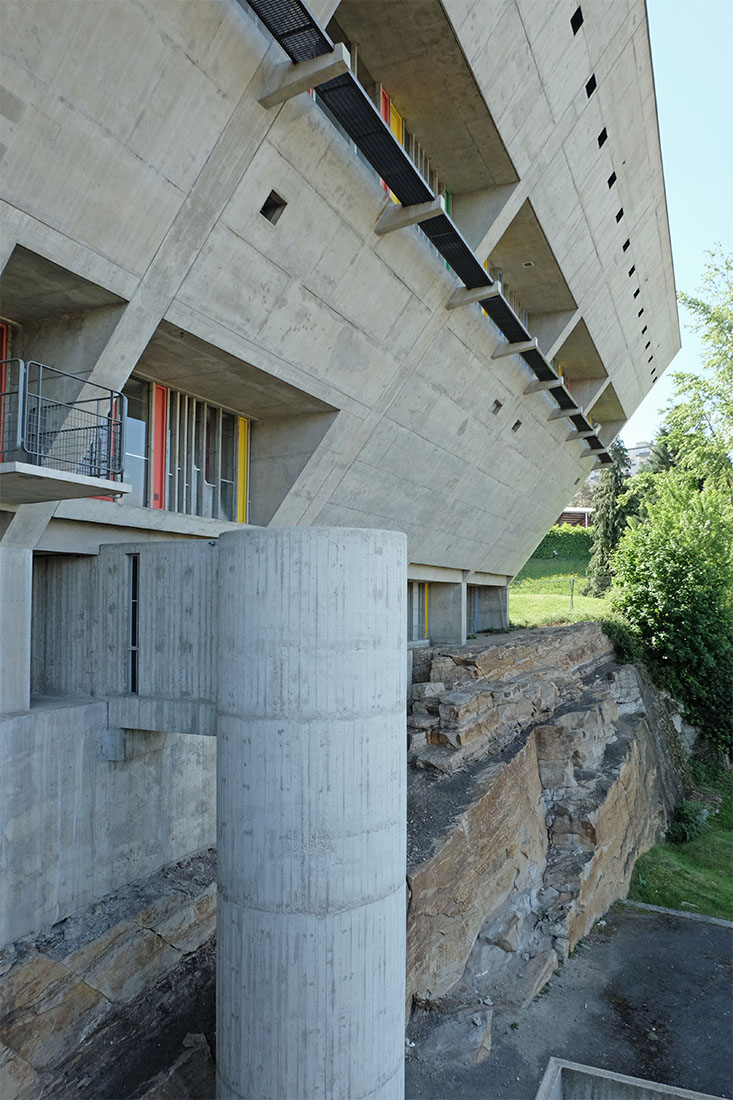 |
 |
 |
 |


Maison de la Culture
Rue Saint-Just Malmont, Firminy
1961 - 1965
The youth and culture house in Firminy is part of a larger planning for the district Firminy-Vert. Apart from the Youth and Culture Center, Le Corbusier designed a stadium, a church and a Unité d'Habitation. The concept for the building is based on the program of the Minister of Culture André Malraux. However, the cultural center built in the years 1961 - 1965 is the only building in Firminy that was completed during the lifetime of the architect. The long-drawn building with a length of 112 meters is located in a former quarry, and attracts attention with its unusual appearance.
Originally, this building was planned as a roof over the stadium grandstands. During the planning, however, the decision was made for a changed location and for an extended program. Le Corbusier, however, decided to maintain the form and arrangement already elaborated and transferred the new functions to the structure. In the course of the planning process, the program was expanded again, so that the youth center became a youth and cultural center. The new program also included a large auditorium. The originally planned construction method with conventional rows of columns would have had a negative effect on the auditorium. In this sense, the auditorium was crucial for the choice of the impressive suspended roof, which acts as an inverted vault. The exterior appearance of the building reflects the construction of the suspended roof. At about the same time, the suspension bridge from Tancarville over the river Seine had been completed. Le Corbusier was also able gain the construction company of the bridge for the Youth and Culture House in Firminy.
As is often the case in the designs of Le Corbusier, the main volume is detached from the ground and raised onto the so-called Pilotis. Walls and columns are made of exposed concrete. The suspended roof consists of prefabricated concrete slabs supported by steel tensioning ropes. These tensioning cables are anchored in the edge beams on the east and west sides. The two longitudinal facades are inclined outwards, and seem to counter balance the suspended roof. The west facade is dramatically overhanging the slope. This inclination of the west façade is used in the interior for the arrangement of stepped rows of seats. On a short façade there is a concrete relief, designed by Le Corbusier, and executed by local workers according to his advice. Also noteworthy are the concrete rungs which divide the glazing into sections of different widths. The undulating rhythm is based on the Modulor Proportion System.
Since 1984, the building is considered a historical monument. Nevertheless, it is still used today for its original purpose as a venue for performances and various activities of the community and music school. The building can be visited by interested people.
Das Jugend- und Kulturhaus in Firminy ist teil einer grösseren Planung für den Stadtteil Firminy-Vert. Le Corbusier entwarf abgesehen vom Jungend- und Kulturhaus ein Stadion, eine Kirche und eine Unité d'Habitation. Das Konzept für das Gebäude entstand aus dem Programm des Kulturministers André Malraux. Allerdings ist das in den Jahren 1961 - 1965 erbaute Kulturzentrum das einzige Gebäude in Firminy, welches zu Lebzeiten des Architekten fertiggestellt werden konnte. Das langggezogene Gebäude mit einer Länge von 112 Metern befindet sich in einem ehemaligen Steinbruch, und zieht mit seiner ungewöhnlichen Erscheinung die Aufmerksamkeit auf sich.
Ursprünglich war dieses Gebäude als Überdachung der Stadiontribünen geplant. Während der Planung fiel jedoch der Entscheid für einen geänderten Standort und für ein erweitertes Programm. Le Corbusier entschied sich aber die bereits erarbeitete Form und Anordnung beizubehalten, und übertrug die neuen Funktionen auf die Struktur. Im Verlauf des Planungsprozesses wurde das Programm nochmals ausgeweitet, so dass aus dem zwischenzeitlichen Jugendzentrum ein Jugend- und Kulturhaus wurde. Das neue Programm enthielt auch einen grossen Theatersaal. Die ursprünglich angedachte Konstruktionsweise mit konventionellen Stützenreihen hätte sich negativ auf den Theatersaal ausgewirkt. In diesem Sinne war der Theatersaal ausschlaggebend für die Wahl des Hängedachs, welches wie ein umgekehrtes Gewölbe wirkt. In der äusseren Erscheinung des Gebäudes widerspiegelt sich das Hängedach. Etwa zur selben Zeit war die Hängebrücke von Tancarville über die Seine fertiggestellt worden. Le Corbusier konnte die ausführende Baufirma der Brücke auch für das Jugend- und Kulturhaus in Firminy gewinnen.
Wie so Oft in den Entwürfen von Le Corbusier ist auch beim Jugend- und Kulturhaus der Hauptbaukörper vom Erdboden losgelöst und auf sogenannte Pilotis angehoben. Wände und Stützen sind aus Sichtbeton errichtet. Das Hängedach besteht aus elementierten Betonplatten, welche von stählernen Spannseilen getragen werden. Diese Spannseile sind auf der Ost- und Westseite jeweils in den Randbalken verankert. Die beiden Längsfassaden sind nach aussen geneigt, und scheinen sich dem Hängedach entgegenzustemmen. Die höher aufragende Westfassade ist dabei dramatisch über den Abhang auskragend. Diese Neigung der Westfassade wird im Innenraum für die Anordnung von abgetreppten Sitzreihen genutzt. An einer Kurzfassade gibt es ein Betonrelief, welches von Le Corbusier entworfen, und von den lokalen Arbeitern nach seinen Anweisungen ausgeführt. Bemerkenswert sind zudem die Betonsprossen, welche die Verglasung in unterschiedlich breite Abschnitte unterteilt. Der ondulierende Rhythmus basiert auf dem Modulor Proportionssystem.
Seit 1984 wird das Gebäude als historisches Denkmal betrachtet. Dennoch wird es heute noch für seinen ursprünglichen Zweck als Veranstaltungsort für Aufführungen und verschiedene Aktivitäten der Gemeinde und Musikschule genutzt. Das Gebäude kann von Interessierten besichtigt werden.